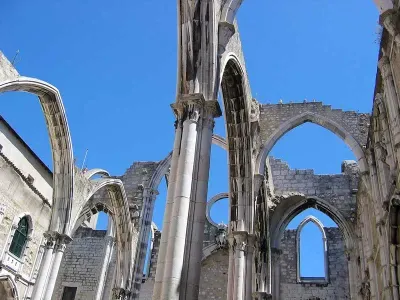
Earthquake, tsunami and firestorm
On All Saints Day (1st November) 1755, at 9.40 in the morning, a huge earthquake, which modern scientists believe to have measured between 8.5 and 9 on the Richter Scale, struck in the Atlantic Ocean, about 120 miles off Cape St Vincent on the Portuguese coast. Over a ten minute period, three shocks are said to have occurred, ripping giant fissures up to 15 feet (5 metre) wide through the heart of the city of Lisbon.
Many of Lisbon's inhabitants were in the city’s magnificent churches, celebrating the feast day. Most notable among these was the imposing Carmo Convent set overlooking the city's downtown district. The fine Gothic church was packed with worshippers when the earthquake struck bringing the roof down and crushing much of the congregation inside.
To make matters worse many candles had been lit throughout the city in celebration of All Saints Day. This only served to magnify the disaster as they caused fires to break out which soon engulfed the remaining parts of the city that had not been affected by the earthquake. In the ensuing firestorm hundreds of patients at the Hospital Real burned in their beds as they were unable to flee. Many of the citizens of Lisbon that could escape the flames fled to the waterfront with some boarding boats to head into the safety of the river. It is said that the fire raged for five days after the quake reducing two thirds of the city to ash.

Unfortunately, this was not the end of the disaster. About 40 minutes after the initial shock, tsunami waves said to have been more than 18 feet (6 meters) high reached the shores of Lisbon. Before they struck, the waters retreated, draining the estuary of the River Tejo and revealing a number of shipwrecks that lined the basin. Many individuals rushed to claim treasure that might have been aboard whilst others looked on oblivious of the coming tsunami.
It is said the waves travelled faster than the men on horseback who tried to escape them. Those on the shoreline stood little chance as the wall of water ploughed into Lisbon's seafront. The boats loaded with refugees out in the Tejo fared little better with many overturned and sunk.
There is no precise record of the number of people who perished in what came to be known as the "Lisbon Earthquake". In fact, this is somewhat of a misleading name, because the entire Portuguese coast was devastated including much of the Algarve coast, which was left in ruins. The worst damage occurred in the city of Lisbon because it was the most densely populated area in the immediate trail of destruction left by the earthquake. Many thousands of people were also killed in Morocco, whilst the tremors were felt as far afield as the southern coast of Ireland and Great Britain, and tidal waves even reached the Portuguese colony of Brazil on the far side of the Atlantic Ocean.
In Lisbon, 85% of the buildings were destroyed and the historian Alvaro Pereira estimated that between thirty and forty thousand inhabitants perished from a population of around two hundred thousand. It was certainly one of the most costly earthquakes in history. In purely financial terms it cost Portugal almost half of its Gross Domestic Product and put an end to any future hopes of Portuguese exploration. Many historic artefacts, tapestries, books, and works of art that were housed in the city were destroyed and lost forever.
In the aftermath of the earthquake people looked for an explanation of what had caused it. The religious zealots of the day were all to ready to blame the destruction on the alleged sins of the city's population. In the following months the Portuguese Inquisition rounded up many heretics to hang or burn as a form of atonement.

The silver lining to this horrific event was that it acted as a precursor to the scientific study of seismology. The devastation and loss of life caused by the quake created a drive for more earthquake resistant buildings to be created; something that had never even been considered before. Sebastião José de Carvalho e Melo, the Marquis de Pombal (serving Prime Minister at the time of the tragedy) was responsible for the rapid re-building of the Baixia district in Lisbon, where the world’s first ever earthquake-resistant buildings still stand today. Not only was the method of construction revolutionary, the style and street plan was decidedly modern. The buildings were rather functional in design, somewhat of a change from the ostentatious facades that were previously favoured. In addition the layout was based on a grid pattern with wide avenues - quite the opposite of the organic street plan that existed previous to the earthquake.